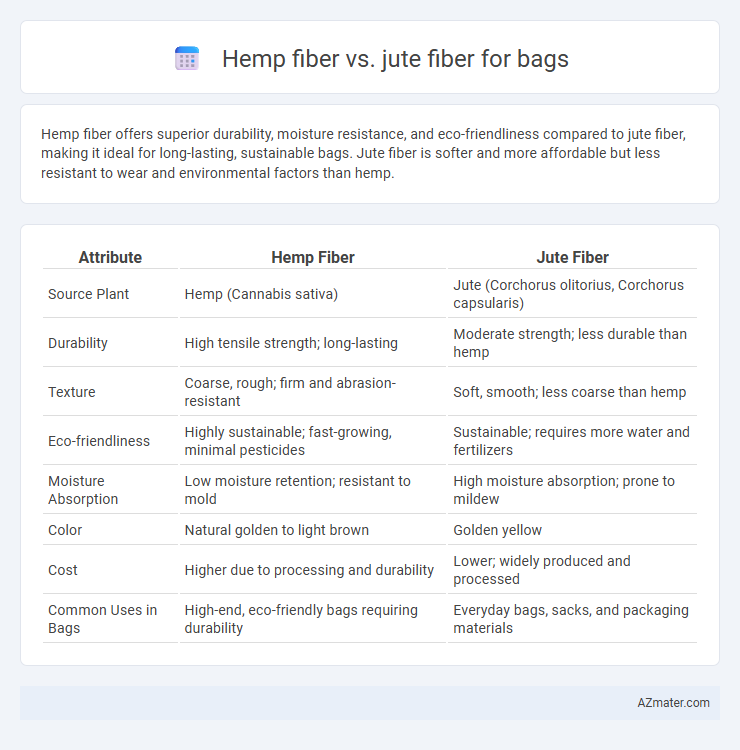Hemp fiber offers superior durability, moisture resistance, and eco-friendliness compared to jute fiber, making it ideal for long-lasting, sustainable bags. Jute fiber is softer and more affordable but less resistant to wear and environmental factors than hemp.
Table of Comparison
| Attribute | Hemp Fiber | Jute Fiber |
|---|---|---|
| Source Plant | Hemp (Cannabis sativa) | Jute (Corchorus olitorius, Corchorus capsularis) |
| Durability | High tensile strength; long-lasting | Moderate strength; less durable than hemp |
| Texture | Coarse, rough; firm and abrasion-resistant | Soft, smooth; less coarse than hemp |
| Eco-friendliness | Highly sustainable; fast-growing, minimal pesticides | Sustainable; requires more water and fertilizers |
| Moisture Absorption | Low moisture retention; resistant to mold | High moisture absorption; prone to mildew |
| Color | Natural golden to light brown | Golden yellow |
| Cost | Higher due to processing and durability | Lower; widely produced and processed |
| Common Uses in Bags | High-end, eco-friendly bags requiring durability | Everyday bags, sacks, and packaging materials |
Introduction to Hemp and Jute Fibers
Hemp fiber, derived from the stalks of the Cannabis sativa plant, is known for its exceptional strength, durability, and resistance to mold and UV light, making it an ideal choice for sustainable bag production. Jute fiber, obtained from the bark of the Corchorus plants, is valued for its affordability, biodegradability, and excellent breathability, commonly used in eco-friendly bags and packaging. Both fibers are natural, renewable resources widely utilized in the textile industry, with hemp offering higher tensile strength and jute providing a softer texture.
Origins and Cultivation Methods
Hemp fiber, derived from the stalks of the Cannabis sativa plant, is cultivated primarily in temperate climates with minimal pesticide use due to its natural pest resistance. Jute fiber comes from the Corchorus plant, thriving in warm, humid environments, especially in regions like Bangladesh and India, and is often grown in water-abundant soils with manual harvesting techniques. Both fibers are renewable and biodegradable, but hemp cultivation generally requires less water and grows faster than jute, making it a more sustainable option for bag production.
Fiber Extraction Processes
Hemp fiber extraction involves retting, where stalks are soaked or dew-rotted to separate fibers, followed by decortication to remove woody parts, yielding strong, long fibers ideal for durable bags. Jute fiber extraction primarily relies on water retting, a microbial process that softens the jute stalks and allows easy separation of fibers, producing coarse but flexible material commonly used for eco-friendly bags. Both processes significantly influence fiber quality and bag durability, with hemp's mechanical separation yielding higher tensile strength compared to jute's microbial retting.
Strength and Durability Comparison
Hemp fiber exhibits superior strength compared to jute fiber, making it ideal for heavy-duty bags that require high tensile strength and resistance to wear. Its long, resilient fibers contribute to enhanced durability, allowing hemp bags to withstand rough handling and prolonged use without significant degradation. While jute offers moderate durability suitable for lightweight applications, hemp's robustness ensures longer-lasting performance and better structural integrity under stress.
Environmental Impact and Sustainability
Hemp fiber exhibits a significantly lower environmental impact than jute fiber due to its rapid growth cycle and minimal need for pesticides or herbicides, promoting soil health and reducing chemical runoff. Hemp's higher yield per acre and ability to regenerate soil make it a more sustainable choice for bag production compared to jute, which requires more water and intensive processing. The biodegradability and strong durability of hemp fiber contribute to long-lasting, eco-friendly bags with a smaller carbon footprint throughout their lifecycle.
Texture and Aesthetic Differences
Hemp fiber offers a coarser texture with a slightly rougher feel compared to jute, which is softer and smoother, making hemp ideal for more rugged, durable bags. Aesthetically, hemp fibers display a natural, muted greenish-brown hue, while jute tends to have a warmer golden-brown tone, lending a rustic yet polished appearance. The tighter weave possible with jute results in a finer, more uniform fabric, whereas hemp's fibrous texture accentuates a natural, organic look favored in eco-friendly fashion.
Cost Analysis and Market Availability
Hemp fiber offers higher durability and sustainability but comes at a premium cost, often 20-30% more expensive than jute fiber, influencing price-sensitive bag manufacturing markets. Jute fiber remains widely available and commercially dominant, with abundant cultivation in countries like India and Bangladesh, ensuring consistent supply and lower raw material costs. Market trends show increasing demand for hemp in eco-conscious segments, while jute maintains a stronghold in traditional, budget-friendly bag production due to its cost efficiency and extensive availability.
Bag Manufacturing: Ease and Challenges
Hemp fiber offers superior durability and resistance to moisture, making it easier to work with in bag manufacturing due to its strength and minimal need for chemical treatment. Jute fiber, while cost-effective and biodegradable, presents challenges with brittleness and lower tensile strength, often requiring blending with other fibers to enhance durability for bag production. The processing of hemp fibers is more environmentally sustainable, but it demands specialized equipment, whereas jute processing is simpler but results in less robust bags.
Suitability for Various Bag Types
Hemp fiber is highly durable and resistant to wear, making it ideal for heavy-duty bags such as backpacks and tote bags that require strength and longevity. Jute fiber, with its coarse texture and eco-friendly properties, excels in creating lightweight, breathable bags like shopping sacks and casual beach totes. Both fibers offer sustainable alternatives, but hemp's superior tensile strength suits rugged, long-lasting bags, while jute's natural aesthetic fits stylish yet functional everyday carry options.
Consumer Preferences and Trends
Hemp fiber offers superior durability and eco-friendliness, appealing to consumers seeking sustainable, long-lasting bags. Jute fiber remains favored for its affordability and natural rustic look, attracting budget-conscious buyers valuing traditional aesthetics. Current trends show a growing preference for hemp due to its biodegradability and strength, while jute maintains steady demand in the handmade and artisanal bag markets.

Infographic: Hemp fiber vs Jute fiber for Bag
 azmater.com
azmater.com